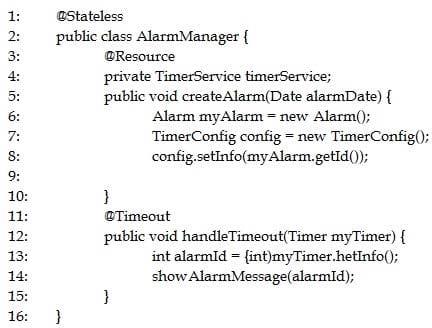1Z0-900 Online Practice Questions and Answers
What is true about Message-Driven Beans (MDBs)?
A. MDBs can participate in transactions.
B. MDBs are invoked synchronously.
C. Each MDBs can process messages only from a single client.
D. MDBs retain data caches between client calls.
How do you specify a default error page in your web.xml file?
A.
B.
C.
D.
Given:

Which client-side Java method will send the employee object to the WebSocket Server Endpoint?
A. session.post(employee);
B. container.send(employee);
C. session.send(employee);
D. remote.sendObject(employee);
Given:

You are creating an Alarm management system. When you create a new alarm, you want it to create an alert that is triggered once at the specified time.
Which method should you call on Line 9 to create the timer?
A. timerService.createCalendarTimer(alarmDate, config);
B. timerService.createSingleActionTimer(alarmDate, config);
C. timerService.createIntervalTimer(alarmDate, -l, config);
D. timerService.createTimer(alarmDate, -l, config);
Which statement is true about JAX-RS resource implementation?
A. The REST resource implementation class must extend the javax.ws.rs.core.Application class
B. The REST resource class can be implemented as a stateful Enterprise JavaBean (EJB).
C. The REST resource class can be implemented as a Plain Old Java Object (POJO).
D. The REST resource implementation class must not be final.
Given an HttpServletRequest request and an EJB SessionContext ctx.
Which is a valid way to retrieve the Principal invoking either behavior?
A. request.getCallerPrincipal() and ctx.getCallerPrincipal()
B. request.getUserPrincipal() and ctx.getUserPrincipal()
C. request.getCallerPrincipal() and ctx.getUserPrincipal()
D. request.getUserPrincipal() and ctx.getCallerPrincipal()
Your web application requires logic to remember items that a user placed into a shopping cart.
Which two mechanisms should you use to associate that information with the user? (Choose two.)
A. HttpServletResponse objects
B. ServletContext objects
C. HttpSession objects
D. a database
What does the system do if you have not entered a count for a tag during physical inventory process?
A. It will adjust your on-hand balances down to zero quantity.
B. You will not be able to post without a quantity for every tag.
C. Any adjustment will be rejected.
D. It will consider the current system quantity.
E. A warehouse person will be notified.
Which action invokes supply chain orchestration and transfer of data to supply chain orchestration Interface tables?
A. creating Purchase Order Receipt
B. running a scheduled process called "Create Transactions"
C. running Min-Max Planning
D. creating a new Inventory Organization for execution of supply chain orchestration
Your client has decided that Discrete Manufacturing will be implemented at a future stage, so any new supply from current manufacturing will be added to current inventory by the Open Transactions Interface. The immediate requirement is to go live with Inventory and Order Management.
Which two seeded transaction types can be omitted for material status control?
A. All Transaction Types Related to Work in Process
B. Average Cost Update
C. Backflush Subinventory Transfer
D. Miscellaneous Issues and Receipts
E. All Internal Transactions